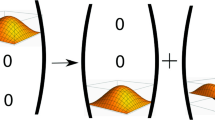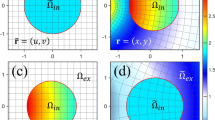Conclusions
We see that the behavior of the spectral curves near regions of mode interaction can be reconstructed by determining the set of Morse critical points and the expansion (3). If these curves are augmented with corresponding asymptotes of the form Re ϰ(L) → ν n /2πθL≫1, Im ϰ(L) → 0 fairly detailed information can be obtained about the behavior of the eigenfrequencies of the investigated structure. This approach is most effective in cases where mode interaction can be expected beforehand on the basis of general considerations when the sequence of excitation of the OWC and the energy-converting properties of its boundaries are known. By solving Eq. (4), we can predict unambiguously whether such interaction will take place and, if so, for what geometrical and frequency parameters. Once the coordinates of the Morse point are known, the structure of the field can also be effectively and deliberately varied without any appreciable change in the OWC geometry.
Similar content being viewed by others
Literature Cited
V. B. Shteinshleiger, Dokl. Akad. Nauk SSSR,65, No. 5, 669 (1949).
V. B. Shteinshleiger, The Mode Interaction Phenomenon in Electromagnetic Resonators [in Russian], Oborongiz, Moscow (1955).
P. E. Krasnushkin, Radiotekh. Élektron.,19, No. 7, 1345 (1974).
V. N. Koshparenok, P. N. Melezhik, A. E. Poedinchuk, and V. P. Shestopalov, Dokl. Akad. Nauk SSSR,279, No. 5, 1114 (1984).
V. P. Shestopalov, A. A. Kirilenko, and L. A. Rud', Resonance Scattering of Waves, Vol. 2: Waveguide Inhomogeneities [in Russian], Naukova Dumka, Kiev (1986).
L. A. Rud', Yu. K. Sirenko, V. P. Shestopalov, and N. P. Yashina, IRÉ AN Ukr. SSSR Preprint No. 327 [in Russian], Institute of Radiophysics and Electronics, Academy of Sciences of the Ukrainian SSR, Kharkov (1986).
P. N. Melezhik, A. E. Poedinchuk, Yu. A. Tuchkin, and V. P. Shestopalov, Dokl. Akad. Nauk Ukr. SSR, Ser. A, No. 8, 53 (1987).
R. Gilmore, Catastrophe Theory for Scientists and Engineers, Wiley-Interscience, New York (1981).
Yu. K. Sirenko, V. P. Shestopalov, and N. P. Yashina, Radiotekh. Élektron.,32, No. 3, 535 (1987).
A. A. Kirilenko, V. P. Shestopalov, and N. P. Yashina, Zh. Vyschisl. Mat. Mat. Fiz.,17, No. 6, 1482 (1977).
A. A. Kirilenko and N. P. Yashina, Radiotekh. Élektron.,27, No. 11, 2140 (1982).
L. A. Rud', Yu. K. Sirenko, V. P. Shestopalov, and N. P. Yashina, Algorithms for the Solution of Spectral Boundary-Value Problems Associated with Open Waveguide Cavities, IRÉ AN Ukr. SSR Preprint No. 318 [in Russian], Institute of Radiophysics and Electronics, Academy of Sciences of the Ukrainian SSR, Kharkov (1986).
B. V. Shabat, Introduction to Complex Analysis [in Russian], Nauka, Moscow (1969).
N. I. Danilina, N. S. Dubrovskaya, and O. P. Kvasha, Numerical Methods [in Russian], Vysshaya Shkola, Moscow (1976).
Additional information
Institute of Radiophysics and Electronics Academy of Science of the Ukrainian SSR, Kharkov. Translated from Izvestiya Vysshikh Uchebnykh Zavedenii, Radiofizika, Vol. 32, No. 8, pp. 1000–1008, August, 1989.
Rights and permissions
About this article
Cite this article
Pochanina, I.E., Shestopalov, V.P. & Yashina, N.P. Hybrid modes of open waveguide cavities (numerical and analytical investigation). Radiophys Quantum Electron 32, 744–752 (1989). https://doi.org/10.1007/BF01060009
Received:
Issue Date:
DOI: https://doi.org/10.1007/BF01060009




